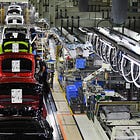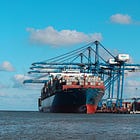AI, Productivity, and Prosperity
Economic gains from AI depend on who captures and reinvests them

Artificial intelligence is everywhere. Big tech is investing heavily, politicians are heralding a bright future, and venture capitalists are rushing to fund startups, convinced AI will deliver unprecedented productivity gains—especially in services, the part of the economy that has long resisted them.
But the reality may be more complex. AI’s impact depends not just on automation, but on who captures and reinvests the gains. Like lean production in the 1970s, AI often optimises existing capabilities rather than creating an entirely new technological revolution. Some sectors and regions are positioned to turn AI efficiency into lasting productivity and economic growth. Others see the benefits leak away as temporary consumer savings, financial speculation, or foreign dependence.
This edition argues that capturing AI’s economic value requires two conditions: the ability to generate and retain producer surplus, and reliable access to the compute-energy stack needed for large-scale deployment. By examining manufacturing and service sectors, along with China, America, and Europe, this edition shows how industrial capacity, infrastructure, and institutions decide who will prosper—and who will be left behind—in the AI economy.
Note (13 October 2025): The reasoning in this post was partly revised and significantly refined in a later edition, which you can read here:
1/ AI repeats the lean production pattern
As I’ve written in previous editions (see here, here and here), my view is that AI represents radical optimisation within the age of computing and networks rather than a new technological revolution. Like lean production in the 1970s, which marked the maturity of the oil and automobile age, AI fundamentally rethinks how to harness mature technologies rather than replacing them.
Lean production reorganised existing assembly lines and standardised parts around flexibility, waste reduction, and continuous improvement. Japan became the main beneficiary through institutional differentiation (long-term employment, keiretsu ties between manufacturers and suppliers) and favourable geopolitics (containerisation, globalisation). The result was Japan’s ability to make better, cheaper products that reshaped global value chains.
Today, AI represents a similar efficiency breakthrough and, just like with lean production, success depends on institutional readiness, process knowledge, and strategic capital deployment at least as much as on the technology itself.
The key question becomes which industries and regions can best capture economic benefit from this lever: where will AI generate productivity gains and, in turn, result in widespread prosperity?
2/ AI drives economic growth through producer surplus
Economic development from AI depends on whether productivity gains flow to producers, who reinvest them, or to consumers, who spend them.
Capitalism, as historian Fernand Braudel defined it, pursues increasing returns to scale and escape from margin-destroying competitive pressure. When successful, it generates economic surplus with capitalists retaining significant shares for reinvestment. With capitalism done right, AI can expand producer margins and create new capital for productive capacity when applied strategically.
The market economy—the other category in Braudel’s general framework for analysing the economy—operates differently. Unlike with capitalism, competition drives prices down, eroding margins toward zero. When AI efficiency gains diffuse through competition, they create consumer surplus. This improves living standards but fails to generate capital for domestic expansion.
This framework exposes a crucial misconception about AI’s economic impact. The technology’s ability to automate work, particularly in services, is widely celebrated. Yet automation itself tells us nothing about value flows. The critical question is whether replacing workers generates reinvestable surplus or merely redistributes existing value.
3/ Why replacing workers doesn’t equal productivity growth
The distinction between producer and consumer surplus is crucial when considering AI’s potential to transform services, the sector that has historically resisted productivity gains. The common narrative in the tech community presents AI as revolutionary because it can automate service work at scale and reduce the number of workers a firm needs. But this view rests on a misunderstanding: while cutting jobs can temporarily improve a company’s margins, it wrongly assumes that replacing workers with machines automatically increases labour productivity and drives economic growth.
When AI replaces a customer service representative or a junior analyst, it lowers labour costs. Measured at the firm level, labour productivity rises because the same output is produced with fewer workers. But higher labour productivity alone does not guarantee wider economic prosperity. In sectors belonging to Braudel’s ‘market economy’, competitive pressures often force firms to pass efficiency gains to consumers through lower prices, leaving the firm with little or no extra value. Output may stay the same with fewer workers, but unit prices fall. And without retained earnings to fund expansion, new investment, or innovation, the productivity gain remains trapped at the firm level. In other words, efficiency improves, but the broader economy sees no lasting increase in productive capacity.
Services also face inherent limits in output, determined more by demand than by production capacity. A law firm using AI for document review does not necessarily handle more cases, if only because a senior partner can manage only so many clients; the firm may simply lower fees under competitive pressure. A bank automating loan processing does not necessarily issue more loans, because the regulator and the central bank prevent it from doing so; as a result, it may simply offer better rates. Likewise, a restaurant using AI wherever it can still faces real estate constraints, as it can host only so many patrons at lunch hour. In all these cases, the efficiency gains benefit consumers rather than increasing the sector’s productive capacity.
Service automation also erodes the process knowledge that supports future productivity growth. When AI handles routine tasks, workers lose the learning opportunities that traditionally build expertise. Unlike manufacturing, where automation typically complements human work—allowing engineers and operators to monitor, adjust, and improve processes while machines handle repetitive tasks—service automation can replace much of the routine work that trains human expertise. Even if workers supervise or handle exceptions, they no longer perform the tasks that develop tacit skills. As a result, efficiency improves and costs fall, but the firm’s capacity to innovate and expand productivity in the future is weakened.
In short, in service sectors, replacing workers with AI can raise measured productivity and reduce costs, but without retained value, reinvestment, or capability-building, these gains rarely translate into sustained economic growth.







